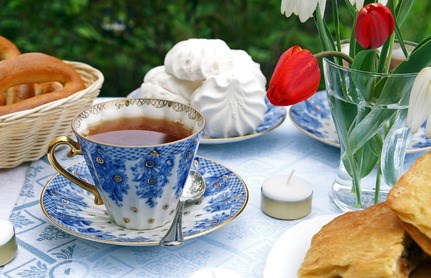Make the most of it... stay overnight
www.booking.comSave up to 40% off UK hotel rooms. The perfect weekend getaway.

www.booking.comSave up to 40% off UK hotel rooms. The perfect weekend getaway.

redletterdays.comIrresistable gifts, including short breaks, thrills, attractions, adventure and gifts.

my.britevents.com/adsThis ad costs just £0.001 per page. Can you afford NOT to buy this advert?
Feature article by BritEvents.
0 Comments
Previous: Camden Market casts new spell
Next:Pancake Customs
There are few British customs that are as well known as the social and relaxing cup of good old-fashioned tea. We take a look at the history of afternoon tea, and explain how tearooms became popular places for relaxation and refreshment.

There are few British customs that are as well known as the social and relaxing cup of good old-fashioned tea. It all began in the mid 17th century and was introduced, surprisingly, by the coffee houses.
Tea began its journey in China in the 28th century B.C. and was discovered by the Chinese Emperor, Shen Nung. He was a very particular man who always requested the boiling of his drinking water, convinced that this would ensure a disease-free life. It was quite by accident that this great discovery was made, and it happened when Shen Nung's servants were requested to boil him some water. Whilst it was boiling, a passing breeze blew leaves from the Camelia bush into the pot of water. The aroma smelt so good that the Emperor had to try some. It tasted as well as he had imagined it to and so Ch'a (as it was known) went on to be the beginning of a whole new part of Chinese culture.
Centuries later, trade with the West opened up and the Dutch introduced tea to continental Europe. It was not until around 1657 1660 that the Dutch East India Company brought tea to English shores.
The first coffee house merchant to introduce tea, was Thomas Garway in 1657. It was very expensive at first and didn't catch on straightaway. With the help of King Charles II, who drank green tea throughout the day, tea soon became popular and by 1700 more than 500 coffee houses were selling it.
Unfortunately, the growth of the tea industry upset the government by reducing the sales of Gin and Ale - hence lowering the government's regular income gained from the taxes off liquor sales. Eventually by 1750 tea had become the favourite drink of the lower classes.
Charles II attempted to control the growth of tea, by forbidding its sale in private houses. The government also tried to control and profit from it, by bringing in an Act in 1676 heavily taxing tea and requiring coffee houses to apply for a licence. This only encouraged smuggling and mixing of tea with other ingredients, such as sloe leaves, liquorice and willow - this obviously helped the tea to go further and therefore added to its profitability. Fortunately, William Pitt the younger brought in an Act to drop the tax on tea and put an end to smuggling. A Food and Drug Act in 1875 finally brought an end to mixing tea with other substances.
In the early 1800's ships could take longer than a year bringing tea from the Far East, so the Clipper was invented. This steamlined, tall-masted vessel was much faster and could cut the journey down considerably. Probably the most famous of these ships is the Cutty Sark.
The Earl of Sandwich may have received a place in history when he decided that it would be a pleasant change to receive his supper between two slices of bread, but it was Anna 7th Duchess of Bedford who brought the idea of having tea in the late afternoon to bridge the gap between lunch and dinner. Dinner was often not served until 8 o'clock in the evening, so this idea was quickly adopted and soon became high tea among the working classes and eventually the main meal of the day.
The Duchess started holding her own tea parties and her guests quickly adopted the same idea. It soon became a competitive function to see who had the best china, tea strains, napkins, etc - even a smock-like garment was invented for Victorian ladies. This interestingly helped to boost the sales of the British pottery industry for companies such as, Spode, Wedgewood and Royal Doulton. Teacups in China had no handles and so there became an increasing demand for cups with handles to suit the British way of drinking tea.
Around 1730, the gardens of Ranelagh and Vauxhall in London served tea accompanied by dancing and fireworks, which proved to be very popular. Their popularity soon spread and tea gardens opened all over Britain.
In 1864, the manageress of the Aerated Bread Company began serving food and drink - saving the tea for all her best customers. Everyone loved the idea and wanted to be a part of it, which eventually lead to the huge success of tearooms. Joe Lyons became the biggest name in the business and opened his first teashop in 1894.
Tearooms soon became much more than just a place to drink tea and have a bite to eat; they were a social meeting place to chat with friends and where un-chaperoned young ladies could visit without damaging their reputations.
Zen Buddists have made the art of serving and drinking tea a meditative practice in Japan. Americans are finding the idea of tea more appealing, by offering fancy pastries and cakes on delicate china to accompany it. Tearooms are becoming more and more popular and seem to be springing up all over the place. Whatever infusion we wish to take, whether it is herbal or green tea, it looks as if the British institution of drinking tea is now becoming popular all over the world.